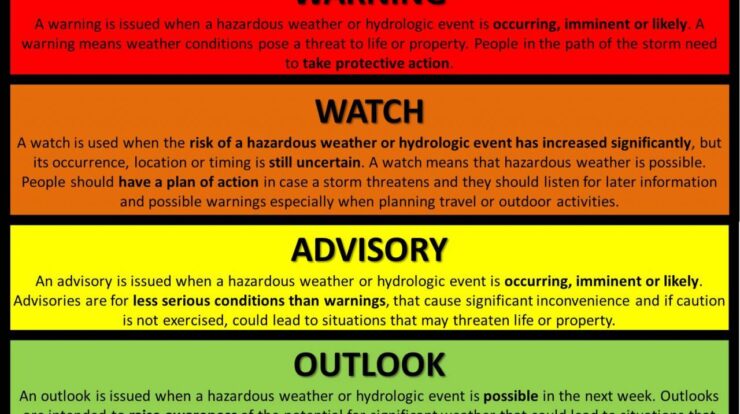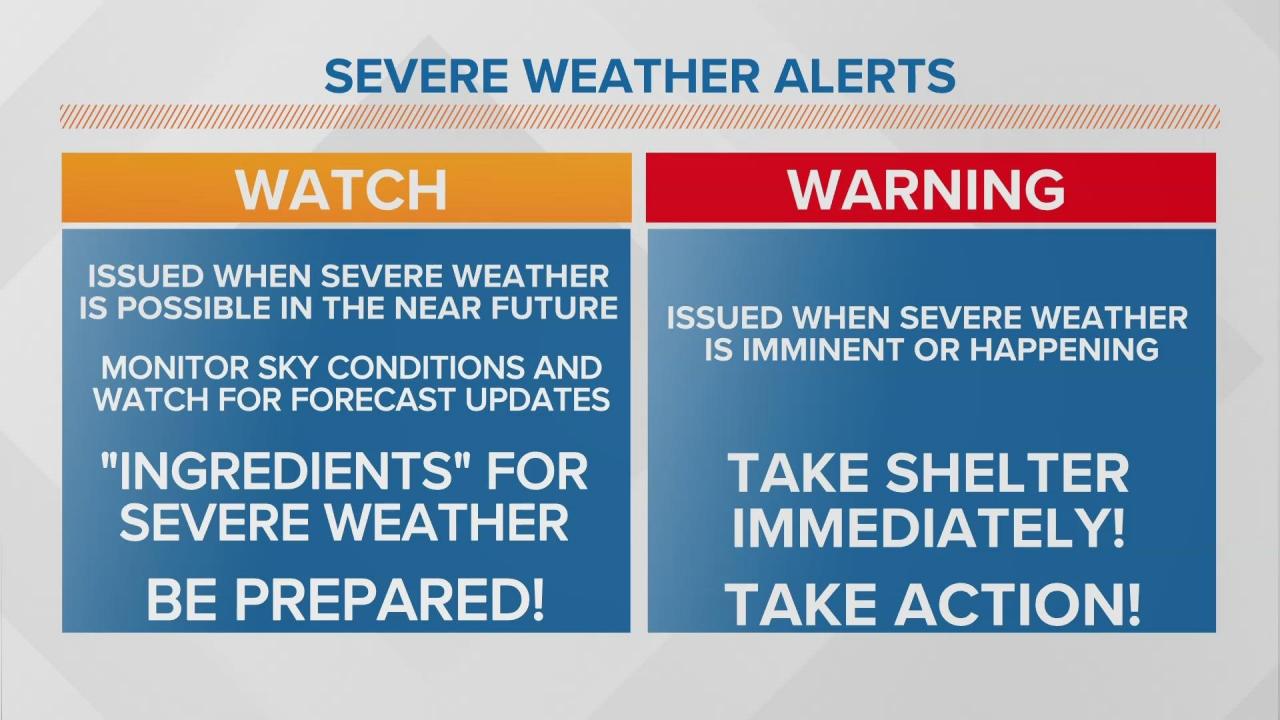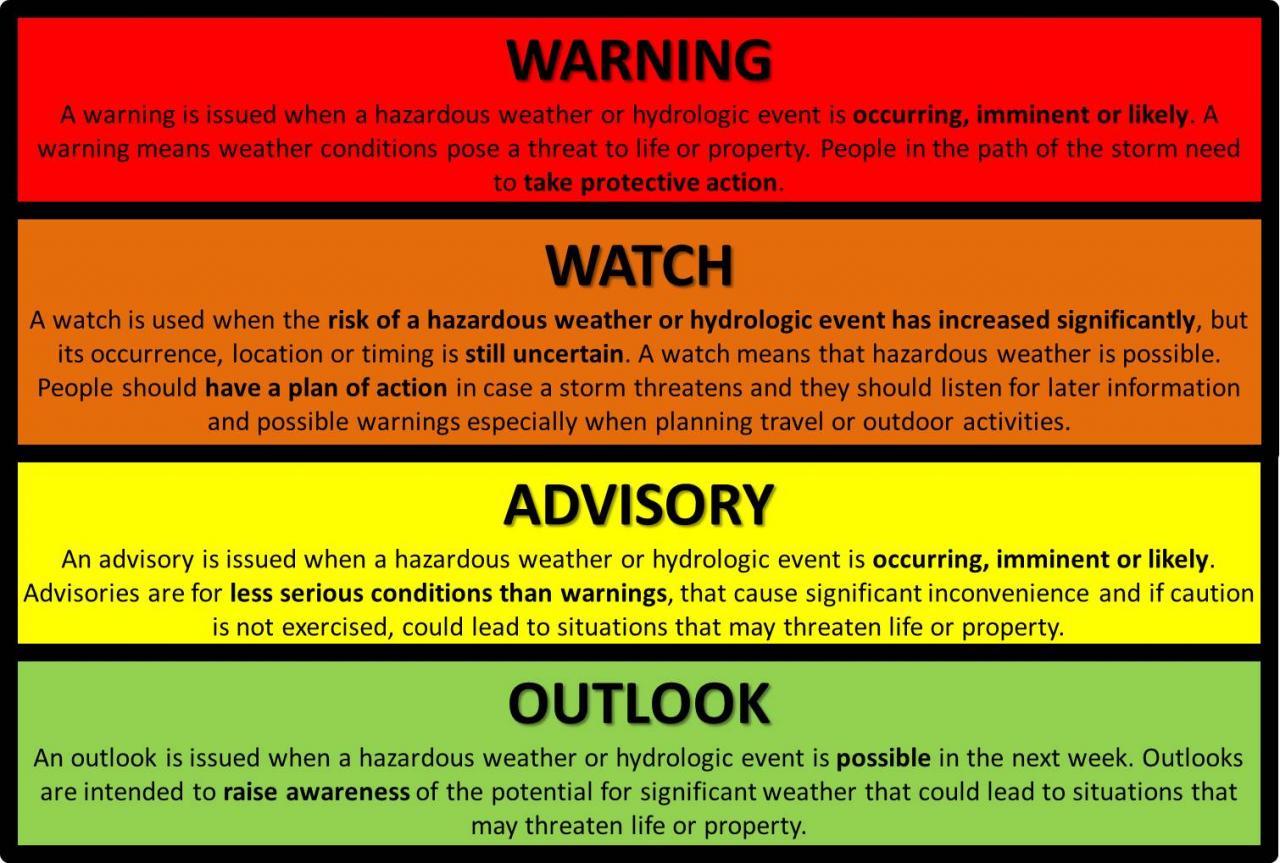
Difference between watch and warning – The difference between a watch and a warning is crucial in weather forecasting, as it determines the severity of an impending weather event and the actions that need to be taken. Understanding the distinction between these two terms is essential for staying informed and prepared during severe weather conditions.
Watches are issued when conditions are favorable for a particular type of severe weather, such as tornadoes, hurricanes, or floods. They indicate that people should be aware of the potential for severe weather and monitor forecasts closely. Warnings, on the other hand, are issued when severe weather is imminent or already occurring.
They indicate that people should take immediate action to protect themselves and their property.
Definition of Watch and Warning
In weather forecasting, “watch” and “warning” are two distinct terms that indicate different levels of potential danger.
A watchmeans that conditions are favorable for a specific weather hazard to develop within a specified time frame, usually within the next 48 hours.
A warning, on the other hand, indicates that the hazard is imminent or already occurring.
For example, a tornado watch would be issued when conditions are right for tornadoes to form, while a tornado warning would be issued when a tornado has been spotted or is indicated by radar.
Severity and Impact
Watches and warnings are issued with different levels of severity.
A watchtypically indicates a lower level of severity than a warning.
For example, a flood watch may be issued when there is a potential for flooding, but there is no immediate danger.
A flood warning, on the other hand, would be issued when flooding is already occurring or is imminent.
Issuance Criteria

The issuance of a watch or warning is based on specific criteria.
For example, a tornado watch is issued when there is a combination of ingredients that are favorable for tornado development, such as strong winds, unstable air, and a lifting mechanism.
A tornado warning is issued when a tornado has been spotted or is indicated by radar.
Communication and Dissemination
Watches and warnings are communicated to the public through a variety of channels, including television, radio, and the internet.
The National Weather Service (NWS) issues watches and warnings for the United States.
It is important for the public to be aware of the difference between a watch and a warning and to take appropriate action when either is issued.
Response and Mitigation
When a watch is issued, it is important to be aware of the potential for severe weather and to take steps to prepare.
Bare-knuckle fighting has made a resurgence in recent years, and there are now several ways to watch bare knuckle fighting live. One option is to purchase a pay-per-view event, which typically costs around $50. Another option is to subscribe to a streaming service that offers bare-knuckle fighting content, such as FITE TV or DAZN.
Finally, you can also watch bare-knuckle fighting on YouTube, as some promotions offer free live streams of their events.
This may include gathering supplies, making an evacuation plan, and staying informed about the latest weather conditions.
When a warning is issued, it is important to take immediate action to protect yourself and your property.
This may include taking shelter, moving to higher ground, or evacuating the area.
For those eager to witness the raw power of bare-knuckle fighting, how to watch bare knuckle fighting has become a hot topic. While the world awaits the highly anticipated film Oppenheimer, how to watch Oppenheimer is on everyone’s mind. And for fans of brutal combat, how to watch BKFC is a must-know.
Remember, there’s a crucial difference between watch and warning in meteorology, so stay informed.
Final Thoughts

Knowing the difference between watches and warnings can help you stay safe during severe weather events. By understanding the severity of each type of alert, you can take appropriate actions to protect yourself and your loved ones.
Quick FAQs: Difference Between Watch And Warning
What is the difference between a watch and a warning?
A watch means that conditions are favorable for severe weather, while a warning means that severe weather is imminent or already occurring.
What should I do when a watch is issued?
When a watch is issued, you should be aware of the potential for severe weather and monitor forecasts closely.
What should I do when a warning is issued?
When a warning is issued, you should take immediate action to protect yourself and your property.





